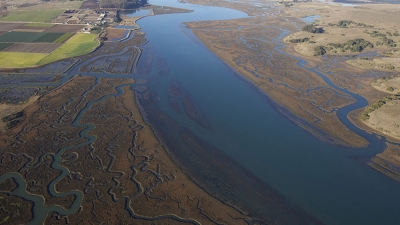
An estuary is an area where a freshwater river or stream meets the ocean. In estuaries, the salty ocean mixes with a freshwater river, resulting in brackish water. Brackish water is somewhat salty, but not as salty as the ocean.
An estuary may also be called a bay, lagoon, sound, or slough.
Water continually circulates into and out of an estuary. Tides create the largest flow of saltwater, while river mouths create the largest flow of freshwater.
When dense, salty seawater flows into an estuary, it has an estuarine current. High tides can create estuarine currents. Saltwater is heavier than freshwater, so estuarine currents sink and move near the bottom of the estuary.
When less-dense freshwater from a river flows into the estuary, it has an anti-estuarine current. Anti-estuarine currents are strongest near the surface of the water. Heated by the sun, anti-estuarine currents are much warmer than estuarine currents.
In estuaries, water level and salinity rise and fall with the tides. These features also rise and fall with the seasons. During the rainy season, rivers may flood the estuary with freshwater. During the dry season, the outflow from rivers may slow to a trickle. The estuary shrinks, and becomes much more saline.
During a storm season, storm surges and other ocean waves may flood the estuary with saltwater. Most estuaries, however, are protected from the ocean’s full force. Geographical features such as reefs, islands, mud, and sand act as barriers from ocean waves and wind.
Credit : National Geographic Society
Picture Credit : Google




